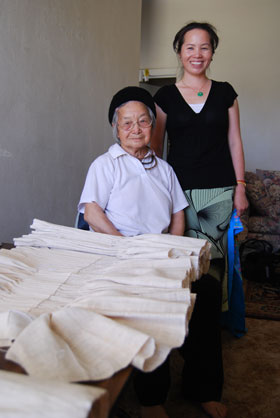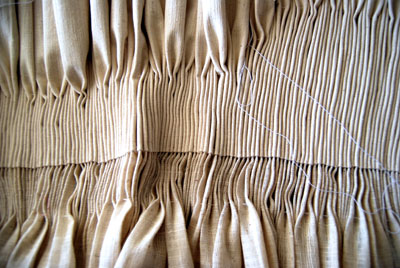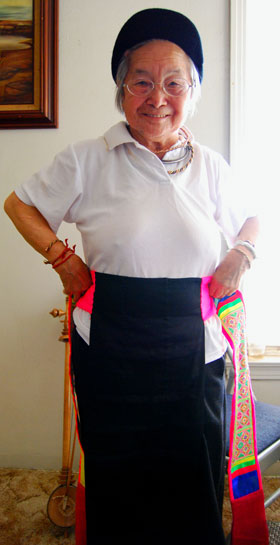 Master artist Ju X. Yang and apprentice and Yang’s daughter-in-law Pao Ge Vue—both of Fresno—are current participants in the Alliance’s Apprenticeship Program completing an apprenticeship in White Hmong tiab dawb, a hand-pleated skirt made of many yards of white hemp fabric, scored, pleated and sewn. An essential part of the traditional White Hmong woman’s ceremonial outfit, the tiab dawb’s pleats are set by tightly wrapping and twisting the skirt in a process which can take several months to a year to complete. In addition to being worn at key times and events in the year, tiab dawb are valued as funeral clothing, and hemp is a preferred fabric for tiab dawb because it decomposes with the body, allowing it to travel with the spirit of the deceased so that one does not arrive to the spirit world unclothed. Yang elaborates: “When a person dies, wearing the collection of very finely made traditional clothes they have collected during their lives has so much meaning spiritually and culturally. When a person gets married, the parents give the bride and groom clothes for their future funeral because we believe that the families will recognize each other in the spirit world by the clothes they have made themselves. It is a very important symbol that helps unite our different clans at marriage.” *
Master artist Ju X. Yang and apprentice and Yang’s daughter-in-law Pao Ge Vue—both of Fresno—are current participants in the Alliance’s Apprenticeship Program completing an apprenticeship in White Hmong tiab dawb, a hand-pleated skirt made of many yards of white hemp fabric, scored, pleated and sewn. An essential part of the traditional White Hmong woman’s ceremonial outfit, the tiab dawb’s pleats are set by tightly wrapping and twisting the skirt in a process which can take several months to a year to complete. In addition to being worn at key times and events in the year, tiab dawb are valued as funeral clothing, and hemp is a preferred fabric for tiab dawb because it decomposes with the body, allowing it to travel with the spirit of the deceased so that one does not arrive to the spirit world unclothed. Yang elaborates: “When a person dies, wearing the collection of very finely made traditional clothes they have collected during their lives has so much meaning spiritually and culturally. When a person gets married, the parents give the bride and groom clothes for their future funeral because we believe that the families will recognize each other in the spirit world by the clothes they have made themselves. It is a very important symbol that helps unite our different clans at marriage.” *
The tiab dawb apprenticeship occurred in their household over weekends and evenings, and was focused on the first-time creation of a tiab dawb by Vue for her own use, a process which took approximately a year to make. Traditionally, tiab dawb is given to a bride from her aunt, for safekeeping until the bride’s funeral. Yang and Vue’s apprenticeship goals included teaching Vue tiab dawb tradition in order to allow her to make more tiab dawb for younger generations including the apprentice’s own daughter and nieces. Yang showed Vue how to make traditional measurements required to fit one’s size based on the anticipated number of pleats—the length of fabric (which averages six yards-long) and the pleating process must be precise in order to yield correct fit. With each pleat, a marking standard must be created using a thumbnail and marking tool mounted to the thumb to mark and measure the pleat prior to scoring it with a needle. Scoring and applying the exact amount of pressure to the needle is an art which creates clear lines and even pleats. As Yang’s son and Vue’s husband Vungping Yang explains, “It requires a lot of self-judgment in determining how many pleats to make so that it doesn’t come out too short or too long.”
 Prior to being worn at ceremonies or cultural events, the tiab dawb is stored by scoring threads through the skirt in order to hold the skirt in place and to affix and reinforce the pleats. When worn, the thread is pulled out of the skirt part of the way so that the skirt opens up “like a pyramid.” After wearing the skirt, new threads have to be scored laboriously through once again.
Prior to being worn at ceremonies or cultural events, the tiab dawb is stored by scoring threads through the skirt in order to hold the skirt in place and to affix and reinforce the pleats. When worn, the thread is pulled out of the skirt part of the way so that the skirt opens up “like a pyramid.” After wearing the skirt, new threads have to be scored laboriously through once again.
Considered by Yang as “highly valued and important in my time,” tiab dawb are traditionally made from hemp fabric, which Yang learned to make on a back-strap loom when she was a girl in the early 1940’s from her aunt and mother in Laos. “In those days, there was no school. So when I started, I worked day and night for it. I even worked with my hands to strip the hemp plant into thread while walking to and from the fields where we worked. If I could finish making the threads with my hands while walking, I would weave on my loom at night before bedtime. When I got married, my husband made me a beautiful loom. I grew my own hemp and every year made new clothes for my family.”
Traditionally, textile arts in Hmong culture are considered important signs of status amongst women. While Yang and Vue have adopted a permanent life in Fresno, those values are still upheld despite Yang’s comment that, “Now, I rarely use my skills anymore. It is always precious to me. I still have a lot of relatives asking to pleat their skirts after their daughters wore them during the Hmong New Year. From time to time I am also asked to make skirts for their daughters. I feel strongly that if my daughter-in-law can inherit these skills from me, it will give her another role to continue the family tradition. When I was her age, I wasn’t as fast and detailed as she is.”
 While Vue had never made a tiab dawb prior to the apprenticeship, she learned how to make paj ntaub (reverse appliqué embroidery) from her mother and others while growing up in the Ban Vinai refugee camp in Thailand. “Making paj ntaub was the only way I could earn money for the family,” selling them to customers and foreigners. Her skill and speed in sewing has benefited her work on tiab dawb. However, she is learning a form which, in comparison to the many paj ntaub she made to sell, is focused on intimate, family- and clan-based traditions rather than “a marketing product” for survival. “Now that I am in the U.S,” she states, “I would like to be able to make [tiab dawb] because this is a very rare skill that is dying with our elders. I would like to carry on this tradition in my community.”
While Vue had never made a tiab dawb prior to the apprenticeship, she learned how to make paj ntaub (reverse appliqué embroidery) from her mother and others while growing up in the Ban Vinai refugee camp in Thailand. “Making paj ntaub was the only way I could earn money for the family,” selling them to customers and foreigners. Her skill and speed in sewing has benefited her work on tiab dawb. However, she is learning a form which, in comparison to the many paj ntaub she made to sell, is focused on intimate, family- and clan-based traditions rather than “a marketing product” for survival. “Now that I am in the U.S,” she states, “I would like to be able to make [tiab dawb] because this is a very rare skill that is dying with our elders. I would like to carry on this tradition in my community.”
Additionally, Vue has appreciated learning the White Hmong textile traditions from Central Laos (Xiengkhouang) from her mother-in-law to expand her own knowledge from western Laos where she and her White-Striped Hmong family hail. “It is important for me as the wife of my husband to learn his family’s textile traditions.”
During the course of the apprenticeship, Vungping Yang has been instrumental in documenting the learning process between his mother and his wife, with hopes to eventually share the traditions and values associated with tiab dawb with elementary schools students in Fresno, particularly in classrooms which have many Hmong-American children. For the time being, as Hmong New Year festivities swiftly approach, Vue joins Yang in preparing tiab dawb, one stich at a time.
* Translation and interpretation courtesy of Vungping Yang.
